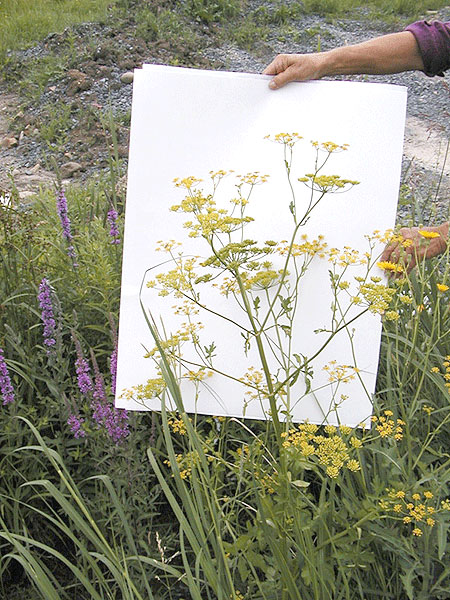Vengeful veggies: Don’t get burned by wild parsnips and giant hogweed
Now and then we all scorch a few vegetables. If you’re as easily distracted as I am, it happens with alarming frequency. I’ll think, the broccoli and cauliflower just came to a boil, so there’s plenty of time to pop out to the garden for chives. Thirty minutes later I’ll be pulling weeds in the corn when the shrill stridency of a smoke alarm indicates the veggies are “done.” Like I said, alarming frequency.
While it sounds absurd to think a vegetable could burn people, it does happen, and this is peak season for it. The burn is chemical in nature, and the vegetable is wild parsnip, an invasive species whose population has exploded in the past decade.
A member of the same family as Queen-Anne’s lace, wild parsnip reaches a height of between three and six feet tall. From mid-June through mid-July, wild parsnip is topped by pale yellow umbrella-like flower clusters. It can be found in vacant lots as well as in yards, pastures, and gardens. But because it’s so effectively spread by mowing equipment, mile upon mile of it can be seen along New York State’s highways and byways.
The root of this weed is in fact edible. It’s nearly identical to the parsnip we might plant in our garden. So what exactly is so objectionable about wild parsnip?
Its sap, like that of the notorious menace the giant hogweed, is phytophototoxic. The tongue-twister word means wild parsnip sap on one’s skin reacts with sunlight to cause second- and third-degree burns. Such burns often take months to heal, and sometimes they leave a permanent scar. The sap can even cause blindness if it gets in the eyes.
It’s a small consolation, but you can’t get burned by merely brushing up against wild parsnip. And once it’s is dry it poses no threat, unlike poison ivy which can cause a rash even after sitting for several years. All the same, it’s a good idea to wear gloves and long sleeves when handling wild parsnip.
As everyone knows, when fighting a zombie, you grab a shovel and aim for its head. The same with wild parsnip, except you aim for its feet. It has a taproot which is very hard to pull out, but is easily cut with a shovel. It’s not necessary to get the whole root—just dig as deep as you can to sever the taproot, pry up and the plant will die. You don’t even have to touch it.
If you’re hopelessly outnumbered by wild parsnips, at least mow them to keep them from making seeds while you muster some shovel-wielding townsfolk (pitchforks and torches are optional) to help you. But wear protective clothing when mowing wild parsnip, and unless you have a Level-A Hazmat suit, don’t use a string trimmer on it.
Glyphosate, the active ingredient in herbicides like Roundup, is effective against wild parsnip. Herbicide is most effective when used on first-year plants (“rosettes”), ones which have no flower stalk, in late summer or early fall. Spraying early in the season will kill the top but not the root, and the plant can come back.
I distinctly remember having scorched some parsnips years ago, so I hope none of this is my fault. I suggest everyone try not to burn any more vegetables, lest they all become vengeful.
For more information on wild parsnip, giant hogweed, or other invasive species, contact your local Cooperative Extension office.
Paul Hetzler is a horticulture and natural resources educator with Cornell Cooperative Extension of St. Lawrence County.
Tags: giant hogweed, invasive plants, wild parsnip









